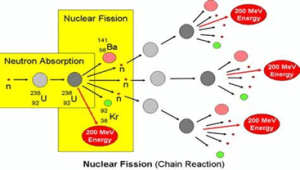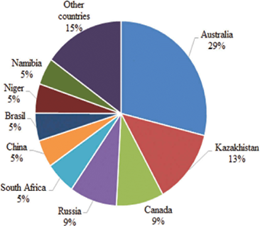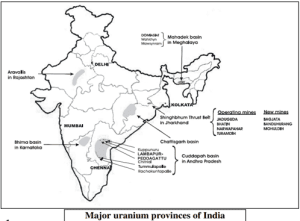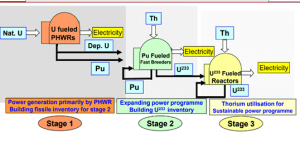Answer.
APPROACH
Introduction- Write a note on nuclear energy production through nuclear fission and share of nuclear energy in India’s total energy basket.
Support it with a diagram depicting the process of nuclear fission.
The Body
- Account in detail the distribution of atomic materials such as uranium and thorium- cover distribution in the world and India using tabular format.
- Draw related maps of India and the world.
- Then discuss the challenges associated with nuclear energy production- focus on issues concerning resource availability, technology, international sanctions/hindrances, environmental concerns, safety issues etc.
- Also, discuss briefly the limitations in harnessing thorium.
Conclusion
- State facts related to total nuclear energy installed capacity in India and what measures need to be taken to expand nuclear energy production, given its advantages.
Introduction:
India produces about 3% of its total electricity from nuclear energy, which is considered non-conventional energy. The chemical reactions involving fission or fusion of atoms can be utilised in the generation of atomic energy. Nuclear Fission largely forms the basis of electricity generation. In this process, the nucleus of heavy atomic elements such as uranium and plutonium are split into lighter elements which release huge amounts of energy.
Nuclear energy production is undertaken under a controlled environment in a nuclear power plant.

The Body-
Distribution of raw materials for nuclear energy production:
Uranium (U-235) and Thorium (Th) are the main atomic minerals vital for atomic energy generation.
1. Distribution of Uranium:
Global distribution
Australia has the largest deposits of uranium in the world, holding a share of about 30% of the global uranium reserves.
This is followed by Kazakhstan, Canada, USA, South Africa, Namibia, Brazil, Niger and Russia.
About two-thirds of the world’s production of uranium comes from Kazakhstan, Canada and Australia.

Distribution in India
Dharwad rocks and the Singbhum-Copper belt of India are known to hold deposits of uranium.
India produces about 2% of the world’s uranium.
Uranium reserves in India are found in the states of:
- Jharkhand- Jadugura, Bhatin, Narwapahar, Bagjata, Baduhurang, Turamdih and Mohuldih
- Andhra Pradesh (Cudappah basin) – Tummalapalle
- Rajasthan– Udaipur, Alwar, Jhunjhunu, Rohil (Sikar)
- Chattisgarh– Durg district
- Maharashtra– Bhandara district
- Meghalaya– Mahadek basin
- Himachal Pradesh– Kullu district
- Uttar Pradesh– Lalitpur region

2. Distribution of thorium:
Thorium is mainly found in the monazite and ilmenite placer deposits in the beach sands.
Global distribution
Monazite sands contain nearly 10% of thorium reserves in contrast to mere 0.3% of uranium reserves.
Thus, thorium is more abundantly available in nature across the world than uranium.
The USA, Australia, Brazil and India are the countries where thorium is distributed globally.
Distribution in India
India is endowed with 25% of the global thorium reserves.
The world’s richest deposits of thorium occur along the sand beaches of the Eastern coast of India, particularly in the states of:
- Kerala- Kollam and Palakkad districts
- Tamil Nadu
- Andhra Pradesh– Vishakhapatnam
- Odisha-Mahanadi River delta
CHALLENGES ASSOCIATED WITH NUCLEAR ENERGY PRODUCTION
- Highly Capital-intensive: The construction and operation of nuclear reactors and the creation of supporting infrastructure require huge capital investments. Pumping in such a large chunk of money into nuclear power production is a big challenge for developing countries like India which have competing needs and cheaper energy alternatives like coal, natural gas and solar energy.
Nuclear power is in the hands of the Government, while renewables attract a high level of private investment, lured by tax holidays and other incentives.
- Safety concerns: The accidents in nuclear power plants where uncontrolled chain reactions take place can prove fatal, as testified by the Chornobyl nuclear disaster(Ukraine-1986) and Fukushima nuclear disaster (Japan-2011), which was earthquake-triggered.
The radioactive elements used in nuclear power plants adversely affect human health, causing mutations in DNA, cancers, foetal abnormalities etc.
The apprehensions of safety and environmental issues lead to protests against nuclear power plants, e.g., protests against the Kudankulum Nuclear Power Plant in Tamil Nadu.
- Inadequate Raw Material- On account of insufficient domestic reserves of uranium in India, the nuclear power plants depend on imported uranium as raw material. However, international supply constraints restrict India’s ability to fully harness nuclear energy. India is not a party to Nuclear Proliferation Treaty (NPT) and Nuclear Supplier’s Group (NSG), which poses hurdles in accessing cheap and quality uranium for nuclear fuel.
- Environmental issues: The nature of nuclear fuels and improper handling of nuclear waste (uranium mill tailings, spent nuclear fuel, hot water etc.) cause radioactive pollution of land, water, soil and air. Such pollutants are long-lived in nature, which is another cause of concern.
The release of hot water into the water bodies has an undesirable impact on the chemistry of water with an adverse influence on the aquatic life and fisheries, causing livelihood losses for local people.
- Land acquisition- The nuclear power plants require large areas for establishing them, thus raising the concerns for locals over land acquisition and subsequent displacement and inadequate compensation and rehabilitation.
- Regulatory lapses: The complex regulatory framework for the development of nuclear energy in India is marred by a slow and bureaucratic structure that causes delays in the implementation of various projects. This is manifested in the slow progress of the Three Stage Nuclear Power Development Programme.
- Hindrances in utilisation of Thorium in India: Despite having a quarter of the world’s thorium reserves, India has not been able to harness its potential. The following factors are responsible:
- Physical properties of Th: Thorium can not be used directly as a fuel in its natural state, so it needs to be converted to Uranium-233 in a nuclear reactor before it can be used as fuel.
- Technological constraints: The utilisation of thorium as nuclear fuel will require the adoption of a closed fuel cycle as envisioned under the 3-stage nuclear power development programme. Apparently, the project is still in the second stage and has not progressed to the last stage, wherein the use of thorium is envisaged. This is attributed to a lack of advanced technology (advanced heavy water reactors) and insufficient availability of U-233 isotopes in the country.

- Nuclear fusion in the experimental phase- In comparison to nuclear fission, nuclear fusion is touted as a cleaner and more sustainable method for electricity production. However, the technical issues, safety concerns and high costs pose problems for harnessing the electricity-producing potential of nuclear fusion.
Conclusion:
Currently, India has 22 operational nuclear power plants contributing to total nuclear power installed capacity of 6780 MW. Expanding the share of nuclear energy in India’s energy basket is imperative, given its contribution in achieving Net-Zero Emissions target by 2070 and ensuring energy security at times when the energy demands are rising tremendously. The need of the hour is to promote investments in cost-effective technologies, cutting down red tape in approval processes, streamlining land reforms and creating special purpose vehicles for the development of nuclear power plants.
Additional information
The existing nuclear power capacity of 6780 MW is planned to be increased to 22480 MW by the year 2031.
Spread the Word
